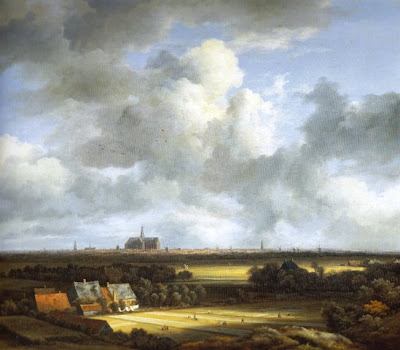Learning to Speak Dutch
When I was just beginning my journey to become a painter I was enrolled at Oberlin College. At the time its Art Department leaned somewhat heavily toward conceptual and avant gard art. Eva Hesse came as a visiting artist to give critiques to the art students ( I was the only one who showed up to hear what she had to say). Overall the key message I received studying art there was that the most important goal for an artist is innovation. Art from the past was important of course, but our job was to make a new art that boldly asserted its independence from all those outworn conventions.
Trouble was, I didn't really like my paintings very much. I knew I was ripe for change. I went on to Bloomington, Indiana and entered their MFA program in painting. I took a course in Baroque art from the art historian Charles Hasthausen. He liked landscapes and showed lots of 'em. That's when I discovered I loved the Dutch Masters. And still more important, I realized that whether or not I wanted to be, I am as much of this time as any other artist. I am a painter who is unable to produce work that looks like it was painted in another century. Coming to that insight gave me the internal permission I needed to scour the past to see how it could help me make my way in the world of painting.
One in particular, Jacob van Ruisdael (1628 - 1682), caught my eye. When he painted a field it seemed to be a portrait of the whole world. No one else so forcefully built up a deep space or carved out such ambitious skies as he did. Ruisdael's oil above shows several tools used beautifully to butress the feeling of space and make it expressively important to the viewer.
Ruisdael invented his own light, dividing the ground plane into distinctly separated areas. In the painting above you can count three clear highlighted areas that say to your eye "close, middle, and far." Coupled with his spotlighting, he maximized the role of simply overlapping forms on top of each other. Look at the way he strategically places his houses at the left just at the back end of the foreground's lighted zone. Their roofs are bathed in sunlight and stack up on top of the large shadowed forest immediately behind them. I'd spend hours studying Ruisdaels in reproductions. I learned he was thougtful, systematic, and brilliantly inventive with his forms and sense of light.
Art books back then leaned more on black and white photography, but that wasn't as much of a handicap as one might think. The Dutch painters of that period were exquisitely sensitive to nuances of tones and the energy to be found in a simple gradation from light gray to darker gray. Previously when I had thought about color in painting I was almost entirely focused on which hue I was employing and how intense (or not) to make it. Falling in love with the 17th century Dutch painters was a personal wake up call to the tonal side of color. To this day I believe one of my best skills as a painter is a heightened awareness of the tonal aspects of color.
Color after all is too complex to be easily held in mind. One sees painters becoming confused about how to manage their hues all the time. We need a fallback position when the dizzying intricacies of color relationships blind us to what we're really doing on our canvases. In that art history class I was discovering the wisdom of darks and lights. Artfully arranged, tones could have a poetry all their own.
Above is another Ruisdael landscape with a very different feel for both color and tone. And below is one of my paintings that shows the same break up the spaces on the ground plane as you see in the Ruisdaels. It's From Day to Night, oil on canvas, 36 x 72", 2011 and is now hanging in the big Unbroken Thread exhibition of my work in the Peninsula Fine Arts Center in Newport News, VA (through Oct. 2, 2011).
Where my work departs from the world of Ruisdael comes in the color choices this former abract artist favors and the far broader paint handling than you would ever see in a baroque era canvas. And there are other, harder to pinpoint differences. We have painting in our world as a tool to show us how the reality of living in our own time feels to us. There's something about a painting from 1930, or 1630, that is different than something made today- you just sense it on an intuitive level. I've been painting daily since 1966 and never has anyone mistaken one of my landscapes for being a 19th century canvas, much less a baroque painting. They never will. In ways that are hard for us to grasp, we just know these things in our bones.





